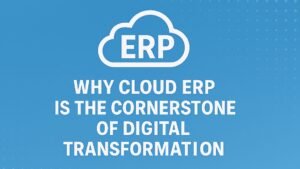In today’s fast-evolving digital economy, Enterprise Resource Planning (ERP) systems are the backbone of business operations — integrating finance, supply chain, manufacturing, sales, and human resources into one unified platform. But when it comes to adopting an ERP, one question keeps business leaders and IT managers debating: Should you choose a subscription-based (cloud) ERP or a license-based (on-premises) ERP?
This question isn’t just about pricing models; it’s about long-term scalability, innovation, and total cost of ownership (TCO). As more businesses move toward cloud-based solutions like Microsoft Dynamics 365, it’s important to understand what each model offers — and which one aligns best with your growth strategy.
In this article, we’ll explore the key differences between subscription and license-based ERP models, their advantages and drawbacks, the financial and operational impacts, and how to choose the right option for long-term success.
Understanding ERP Deployment and Licensing Models
Before diving into comparisons, let’s clarify what these two models mean in practice.
1. License-Based ERP (Perpetual License)
A license-based ERP involves purchasing a software license outright, which gives your company the right to use the software indefinitely. Traditionally, this model is paired with on-premises deployment, where the software is installed on your own servers, and your internal IT team (or a partner) manages the infrastructure, upgrades, and security.
Key Characteristics:
- One-time license purchase fee
- Optional annual maintenance/support fee (usually 15–25%)
- Managed on-premises or in private cloud
- Requires upfront capital investment (CAPEX)
- Customization and upgrades handled manually
Examples: Microsoft Dynamics AX, SAP ECC, Oracle E-Business Suite (legacy editions)
2. Subscription-Based ERP
A subscription-based ERP operates under a pay-as-you-go model. You pay a recurring monthly or annual fee to access the software, which is typically hosted in the cloud by the vendor or a managed partner.
Key Characteristics:
- No large upfront cost — pay per user per month
- Hosted in the cloud (managed by the vendor)
- Continuous updates and upgrades
- Reduced IT maintenance burden
- Operational expense model (OPEX)
Examples: Microsoft Dynamics 365 Business Central, Oracle NetSuite, SAP S/4HANA Cloud
Key Differences Between Subscription and License-Based ERP
| Factor | Subscription-Based ERP (SaaS) | License-Based ERP (Perpetual) |
|---|---|---|
| Cost Structure | Monthly/annual OPEX | One-time CAPEX + maintenance |
| Deployment | Cloud-hosted | On-premises or private cloud |
| Scalability | Easily scalable up or down | Limited by hardware and licenses |
| Upgrades | Automatic, frequent updates | Manual upgrades; costly & disruptive |
| Security & Compliance | Managed by vendor (enterprise-grade) | Managed internally |
| Customization | Limited but configurable | Deep customization possible |
| Integration with Modern Tools | Native integration with cloud apps, AI, Power BI | May require manual integrations |
| Access & Mobility | Accessible anywhere, anytime | Typically on-premises access |
| TCO (Total Cost of Ownership) | Lower over time for SMBs and mid-market | Potentially lower for large enterprises over 10+ years |
Deep Dive: Advantages and Drawbacks of Each Model
Subscription-Based ERP – The Modern Approach
Advantages:
- Lower Upfront Costs
Subscription ERP systems eliminate heavy upfront investments. Businesses can start with minimal capital and scale as needed, making it ideal for small and mid-sized enterprises (SMEs). - Scalability and Flexibility
The pay-as-you-go model allows organizations to easily add or remove users, modules, or functionality. This flexibility is crucial for businesses experiencing seasonal demand or rapid growth. - Continuous Updates and Innovation
Cloud-based ERP systems like Dynamics 365 receive regular updates and new features automatically. You benefit from the latest AI, automation, and security innovations without manual intervention or downtime. - Reduced IT Overhead
Since the ERP is hosted and managed by the vendor, you don’t need to maintain servers or manage upgrades. This frees up internal IT resources for strategic initiatives rather than routine maintenance. - Remote Access and Mobility
With cloud ERP, employees can access the system securely from anywhere, enabling remote work, field operations, and mobile approvals — a must-have in today’s distributed work environment. - Enhanced Security
Leading vendors invest heavily in cybersecurity, data encryption, and compliance standards such as ISO 27001, GDPR, and SOC 2. For most organizations, this security is stronger than what they could achieve on-premises. - Integration with Modern Tools
Cloud ERPs like Dynamics 365 integrate seamlessly with Microsoft Power BI, Teams, Office 365, and AI tools. This integration helps improve data visibility and productivity across the organization.
Drawbacks:
- Ongoing Costs
The subscription fees accumulate over time. For very large enterprises or long-term users, the total cost could eventually exceed the one-time cost of perpetual licensing. - Limited Customization
SaaS solutions often restrict deep code-level customizations to ensure system stability and upgrade compatibility. However, extensions and low-code apps (like Power Platform) offer flexibility. - Vendor Dependence
Your organization is tied to the vendor’s roadmap, infrastructure, and service quality. Any price changes or outages are beyond your direct control. - Internet Dependency
Continuous internet access is required. Any downtime or latency can impact performance, though leading vendors like Microsoft provide robust uptime SLAs (99.9%+).
License-Based ERP – The Traditional Powerhouse
Advantages:
- Full Ownership and Control
Once purchased, the software belongs to you. You can host it wherever you choose, manage data, control upgrades, and decide when to apply patches or enhancements. - Deep Customization
On-premises ERP systems allow extensive customization — from modifying core code to integrating legacy systems — ideal for businesses with unique workflows or compliance requirements. - Long-Term Cost Efficiency (for large enterprises)
While the initial cost is high, organizations that plan to use the system for 10+ years might find it more cost-effective than paying continuous subscription fees. - Offline Availability
Since it’s hosted on local servers, license-based ERP systems can operate even without an internet connection, ensuring continuity in areas with unreliable connectivity.
Drawbacks:
- High Upfront Costs
The initial capital investment — including hardware, licenses, and implementation — can be significant, often reaching into hundreds of thousands or millions for large-scale deployments. - Complex Upgrades
Upgrades are manual, disruptive, and costly. Many companies delay upgrades for years, resulting in outdated systems that lack modern functionality. - Limited Scalability
Scaling up requires purchasing additional licenses, hardware, and IT resources. Scaling down doesn’t recoup costs, making it less flexible during market fluctuations. - Maintenance Burden
Your internal IT team is responsible for updates, patches, security, and uptime — requiring ongoing time and expertise. - Integration Challenges
On-premises ERPs often struggle to connect easily with newer cloud applications, analytics platforms, or AI tools.
Total Cost of Ownership (TCO) Comparison
When evaluating ERP options, cost must be viewed beyond licensing alone. Here’s how both models typically compare across time:
| Cost Element | Subscription ERP (Cloud) | License ERP (On-Premises) |
|---|---|---|
| License | Monthly/annual subscription | One-time perpetual license |
| Infrastructure | Included in subscription | Requires servers, network, backup |
| Maintenance | Included | Annual support fee (15–25%) |
| Upgrades | Included automatically | Paid upgrades (every 5–7 years) |
| IT Staff | Minimal | Dedicated internal team required |
| Security | Managed by vendor | Managed in-house |
| Scalability | On-demand | Hardware-dependent |
| Long-Term Cost (10 yrs) | Potentially higher for very large users | Potentially lower after break-even point |
Insight:
For small and mid-sized businesses (SMBs), subscription ERP typically offers lower TCO and higher agility. For large enterprises with established IT infrastructure and predictable operations, license-based ERP may eventually become more cost-efficient — provided they manage it effectively.
The Future is Cloud – Here’s Why
Over the past decade, the ERP landscape has undergone a massive transformation. According to industry reports, more than 80% of new ERP implementations today are cloud-based. Microsoft, SAP, and Oracle are all transitioning customers from their legacy on-premises products to modern SaaS platforms.
Here’s why cloud subscription models are dominating:
- Continuous Innovation
Cloud ERP vendors continuously roll out new features, AI-driven analytics, and automation tools that help businesses stay competitive without the burden of major upgrades. - AI & Data-Driven Insights
Modern ERPs like Dynamics 365 combine transactional data with advanced analytics, machine learning, and predictive insights — something on-premises systems struggle to achieve without heavy investment. - Global Accessibility
Cloud ERP enables global operations with centralized management. Teams across multiple regions can collaborate seamlessly using real-time data. - Sustainability & Efficiency
Cloud computing promotes energy-efficient infrastructure and reduces carbon footprints — aligning with corporate sustainability goals. - Business Continuity and Security
Vendors ensure high availability, disaster recovery, and compliance with global data regulations — critical for industries like finance, healthcare, and manufacturing.
Which Model Is Right for You?
The decision depends on your size, industry, IT maturity, budget, and growth objectives. Here’s a practical framework:
Choose Subscription-Based ERP (Cloud)
- Are a small or mid-sized business seeking rapid deployment
- Need flexibility to scale users and modules
- Prefer predictable OPEX over CAPEX
- Have limited in-house IT resources
- Want built-in AI, analytics, and integrations
- Operate in a dynamic or remote-work environment
- Value continuous innovation and faster ROI
Choose License-Based ERP (On-Premises) :
- Are a large enterprise with strong IT infrastructure
- Have strict data sovereignty or compliance requirements
- Need deep customization and control over upgrades
- Operate in locations with limited internet access
- Plan to use the system for 10+ years and can absorb upfront CAPEX
- Prefer hosting data within private environments
Hybrid ERP: The Best of Both Worlds
Many companies are now adopting hybrid ERP models, combining the stability of on-premises systems with the flexibility of cloud applications.
For instance, a manufacturer may run core financials and operations in Dynamics 365 Finance (cloud) while maintaining on-premises systems for shop-floor control or legacy integrations. The hybrid model provides a balanced approach to innovation and control.
Benefits of Hybrid ERP:
- Gradual migration to cloud
- Legacy system compatibility
- Reduced risk and disruption
- Choice of deployment for different modules
- Balanced cost and compliance management
Drawbacks:
- Integration complexity
- Dual maintenance
- Potential data synchronization issues
Nevertheless, hybrid ERP serves as a strategic bridge for organizations transitioning from legacy systems toward full digital transformation.
Microsoft Dynamics 365: A Real-World Example
Microsoft Dynamics 365 offers flexible licensing options — subscription-based SaaS as the default model and on-premises deployment for specific industries and compliance needs.
Why it stands out:
- Combines ERP (Business Central, Finance, SCM) and CRM (Sales, Marketing, Customer Service) in one ecosystem
- Seamless integration with Power BI, Power Automate, Azure, and Office 365
- Scalable pricing — pay only for what you use
- Regular updates with cutting-edge AI (Copilot, predictive analytics, automation)
- Global cloud infrastructure with top-tier compliance certifications
For businesses aiming for long-term growth, Dynamics 365’s cloud-first model enables agility, innovation, and scalability while maintaining enterprise-grade security and compliance.
The Strategic View: Long-Term Growth Implications
When evaluating ERP models for long-term growth, think beyond immediate costs — focus on strategic flexibility, innovation velocity, and business resilience.
| Growth Factor | Subscription (Cloud) | License (On-Prem) |
|---|---|---|
| Innovation | Continuous delivery, AI-first | Limited upgrades |
| Scalability | Dynamic scaling | Hardware-dependent |
| Agility | Rapid deployment & updates | Slow change cycles |
| Cost Control | Predictable, flexible | High upfront, low variable |
| Security | Vendor-managed enterprise-grade | Internal responsibility |
| Long-Term ROI | High for fast-growing firms | High for stable enterprises |
| Future Readiness | Built for digital transformation | May require modernization later |
In essence, subscription-based ERP is the better choice for most growing organizations. It offers agility, lower barriers to entry, and constant innovation — all essential in an economy defined by rapid technological change. License-based ERP still has relevance for specific industries and large enterprises needing full control, but even these organizations are gradually adopting hybrid or cloud-first strategies.
Conclusion
Both subscription-based and license-based ERP models have their place in today’s business landscape. However, when it comes to long-term growth, the balance increasingly tilts toward the subscription (cloud) model.
Subscription ERP:
- Enables scalability, mobility, and innovation
- Reduces IT burden and accelerates ROI
- Supports continuous improvement and digital transformation
License ERP:
- Offers full control and deep customization
- May be cost-effective for large, stable organizations with strict compliance needs
For most businesses aiming to future-proof their operations, cloud ERP platforms like Microsoft Dynamics 365 represent the smarter, more sustainable path forward.
As the world continues to shift toward AI-driven, data-centric operations, flexibility and continuous innovation will define success — and subscription-based ERP models are designed precisely for that.
Frequently Asked Questions (FAQs)
Q 1: What is the main difference between subscription and license-based ERP?
Ans: A: Subscription ERP uses a pay-as-you-go (OPEX) model and is typically cloud-hosted, while license-based ERP is purchased outright (CAPEX) and hosted on-premises. The subscription model offers flexibility and continuous updates, whereas the license model provides control and long-term ownership.
Q 2: Is a subscription ERP more secure than an on-premises system?
A:ns:: Yes, in most cases. Cloud ERP vendors like Microsoft invest heavily in enterprise-grade security, encryption, and compliance standards. Unless you have an advanced internal security setup, vendor-managed security is generally stronger and more up-to-date.
Q 3 : Can I customize a subscription-based ERP?
Ans: Yes — though core modifications are limited to preserve system integrity, you can use extensions, APIs, and low-code tools (e.g., Power Platform) to tailor workflows, reports, and integrations.
Q 4: Does subscription ERP cost more over time?
Ans:: It depends on usage and duration. For short to mid-term horizons (up to 10 years), subscription ERP is typically more cost-effective due to lower upfront costs and included maintenance. Beyond that, license-based systems may become cheaper — but at the expense of agility and innovation.
Q 5: Can I migrate from a license-based ERP to a subscription model later?
Ans: Absolutely. Many companies transition gradually using hybrid strategies, migrating modules (like finance or CRM) to the cloud while maintaining others on-premises until they’re ready for full migration.
Q 6: How does Microsoft Dynamics 365 fit into this comparison?
Ans: Dynamics 365 offers cloud-first subscription ERP with modular scalability, AI capabilities, and integration across business functions. It’s ideal for organizations seeking innovation, flexibility, and long-term digital transformation.
Q 7: What about data ownership in cloud ERP?
Ans: You always own your data. Reputable vendors provide data export tools, backups, and transparent policies ensuring that your business data remains accessible and secure.
Q 8: Which ERP model supports remote work better?
Ans: Subscription (cloud) ERP supports remote and hybrid work environments far better due to its web-based, mobile-accessible design and global data availability.
Q 9: Are subscription ERPs suitable for highly regulated industries?
Ans: Yes, most cloud ERPs comply with international standards (GDPR, HIPAA, SOC 2, etc.). However, certain government or defense organizations may still require on-premises or hybrid models for compliance reasons.
Q 10: What is the best long-term strategy for ERP adoption?
Ans: The best approach is a cloud-first strategy — start with subscription-based ERP, keep mission-critical modules hybrid if necessary, and continuously modernize. This ensures agility, security, and cost control over the long term.



